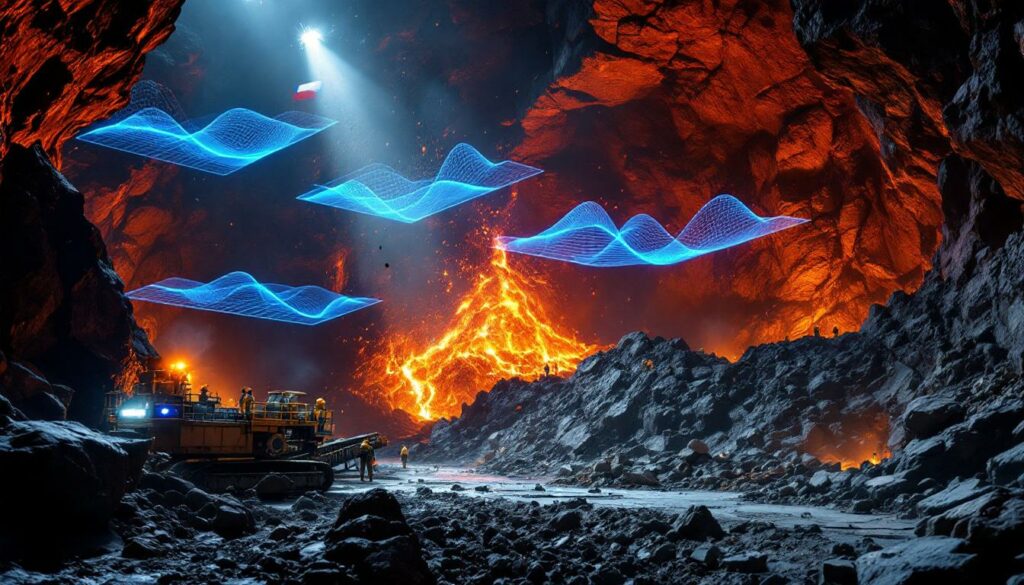Why Did the Codelco El Teniente Mine Collapse Happen?
The July 31, 2025 collapse at Chile's El Teniente copper mine sent shockwaves through the global mining industry, claiming six lives and injuring nine workers. This catastrophic event at one of the world's largest underground copper operations has raised serious questions about mining safety, particularly in deep extraction environments. While initial reports questioned whether a natural earthquake had triggered the collapse, evidence increasingly points to mining-induced seismicity as the primary cause.
Understanding Mining-Induced Seismicity vs. Natural Causes
The 4.2-magnitude seismic event that devastated the newly developed Andesita area within El Teniente appears to have resulted from the mine's own extraction processes rather than natural tectonic movement. According to copper supply analyst Nicolas Munoz, formerly an engineering contractor at El Teniente, these events occur when "parts of the rock cannot accommodate the new stress regime and fail suddenly, releasing stored energy as seismic events."
These mining-induced tremors, often called rock-bursts, occur when:
- Extraction activities redistribute stress within remaining rock formations
- Geological structures experience sudden failure when unable to handle new pressure points
- Energy stored within the rock mass releases in violent, unpredictable ways
- Adjacent mining operations create compounding pressure on remaining structures
"These so-called rock-bursts are very hard to predict in deep and highly active mines," Munoz explains, highlighting why even sophisticated monitoring systems sometimes fail to provide adequate warning.
Technical Factors Contributing to the Collapse
El Teniente employs panel-caving methods, a technique that involves the controlled collapse of depleted mine sections. While efficient for ore extraction, this approach introduces significant complexities:
- Stress redistribution: As sections collapse by design, surrounding areas experience changing pressure profiles
- Depth challenges: At 1,200 meters underground, rock pressure increases dramatically
- Multiple active zones: Simultaneous operations in different areas compound stress throughout the system
- Historical instability: Previous rockfalls in the Andesita area indicated potential ongoing stability issues
The collapse demonstrates how even carefully engineered data-driven mining operations can reach critical failure points when complex geological factors combine unfavorably.
The El Teniente Mine: Scale and Significance
El Teniente isn't just another copper mine – it represents a cornerstone of Chile's economic foundation and plays a critical role in global copper supply chains.
How Important is El Teniente to Global Copper Supply?
As one of the world's largest underground copper operations, El Teniente accounts for approximately 25% of state-owned Codelco's total copper production. This significance translates to substantial market impact during any operational disruption:
| Impact Metric | Daily Value | Monthly Potential | Annual Potential |
|---|---|---|---|
| Production loss | 750 tons | 22,500 tons | 273,750 tons |
| Revenue impact | $7.5 million | $225 million | $2.7 billion |
| % of global supply | ~0.5% daily | ~15% monthly | ~4% annual |
These figures illustrate why even short-term suspensions at El Teniente create ripple effects throughout global copper supply forecast models, particularly during a period of already constrained supply.
Strategic Importance to Codelco and Chile
For Codelco, Chile's state-owned mining giant, El Teniente represents more than just production numbers:
- Financial cornerstone: The mine generates approximately 25% of Codelco's revenue stream
- National significance: Contributes substantially to Chile's export earnings and budget
- Employment center: Provides thousands of direct and indirect jobs in the region
- Technical showcase: Demonstrates Codelco's engineering capabilities in complex mining environments
The extended closure comes at a particularly challenging time for Codelco, which faces significant debt pressures alongside major capital investment commitments. With production already faltering across its operations, the El Teniente disruption compounds financial strain on the company.
Safety Protocols and Restart Challenges
Resuming operations at El Teniente presents a complex web of technical, regulatory, and safety challenges that must be addressed before miners can return underground.
What Must Happen Before Mining Can Resume?
While Codelco has filed requests to restart part of El Teniente mine while investigations continue, industry experts note that comprehensive safety assessments must precede any return to production.
According to Nicolas Munoz: "To restart the mine, Codelco has to satisfy regulators and unions that the whole of the underground operation is stable, not only the affected areas. A comprehensive review of the mine's current plans, particularly the design assumptions and safety criteria applied in all key zones will be needed."
This review process involves several critical components:
- Geological reassessment: Comprehensive mapping of fault lines and stress zones
- Stability modeling: Advanced computational analysis of remaining structures
- Safety system audits: Verification of monitoring equipment and emergency protocols
- Evacuation planning: Updated procedures reflecting new understanding of risk zones
Safety Disclaimer: Mining operations inherently involve risk. While companies implement extensive safety protocols, unforeseen geological events can occur despite precautions. Investments in mining companies should consider these operational risks alongside financial factors.
Technical Challenges Unique to El Teniente
El Teniente faces particularly difficult restart obstacles compared to other mines that have experienced similar incidents:
- Extreme depth: At 1,200 meters underground, pressure and structural forces exceed those of most comparable mines
- Historical instability: Previous rockfalls in the Andesita area suggest potential systemic issues
- Limited remediation options: Unlike shallower mines where larger structural pillars can be installed, El Teniente's depth and existing layout constrain engineering solutions
- Integrated operations: The interconnected nature of the mine's sections means isolated reopening presents significant challenges
These factors combine to create a uniquely complex safety equation that Codelco engineers must solve before operations can safely resume.
Industry-Wide Implications
The El Teniente collapse isn't occurring in isolation – it represents part of a concerning pattern affecting major mining operations globally, particularly those using similar extraction techniques in challenging geological environments.
How Does This Compare to Other Mining Incidents?
In May 2025, just months before the El Teniente disaster, Africa's largest copper mine, Kamoa Kakula, experienced similar self-induced seismic activity leading to flooding. The parallel incidents highlight growing industry concern about mining-induced seismicity:
| Factor | El Teniente (Chile) | Kamoa Kakula (Africa) |
|---|---|---|
| Trigger | Mining-induced seismicity | Mining-induced seismicity |
| Primary impact | Collapse and casualties | Flooding |
| Depth | 1,200 meters | Significantly less |
| Solution approach | Under investigation | Larger structural pillars |
| Production impact | Total suspension | Partial continuation |
The key difference lies in the remediation approach. Kamoa Kakula's operators installed larger structural pillars while accelerating construction in another section. However, El Teniente's greater depth and complex geology make similar solutions less viable.
Broader Industry Safety Concerns
The El Teniente collapse raises fundamental questions about risk assessment in deep underground mining that extend beyond this single incident:
- Prediction limitations: Current technology still struggles to accurately forecast rock-bursts in highly active mines
- Extraction method reassessment: The industry may need to reconsider panel-caving techniques in seismically vulnerable environments
- Monitoring gaps: Even sophisticated sensor networks can miss critical warning signs in complex geological settings
- Depth boundaries: The incident may prompt reconsideration of safe operating depths for certain extraction methods
Mining engineers worldwide will likely study the Codelco collapse caused by mining activity for years, potentially leading to significant revisions in operating procedures for deep underground mining operations.
Economic Impact and Market Response
The suspension of operations at El Teniente creates ripple effects throughout copper markets and places additional pressure on an already strained global supply chain.
What Are the Financial Implications of the Collapse?
For Codelco specifically, the financial impact is immediate and severe:
- Daily revenue loss: Approximately $7.5 million per day of suspended operations
- Remediation costs: Significant unplanned expenditures for stabilization and safety upgrades
- Compensation liabilities: Potential payments to affected workers and families
- Capital reallocation: Resources diverted from planned expansion projects to recovery efforts
These financial challenges couldn't come at a worse time for the state-owned miner, which already faces substantial debt pressures and declining production across its operations.
Effects on Global Copper Markets
The disruption at El Teniente has broader implications for global copper markets:
- Supply constraints: The loss of 750 tons of daily production exacerbates already tight global copper supplies
- Market sentiment: Creates additional uncertainty in a market sensitive to supply disruptions
- Price pressure: Potential upward pressure on copper prices if the closure extends beyond short-term expectations
- Competitor advantage: Other producers may benefit from reduced competition and higher prices
Investment Disclaimer: The information provided represents analysis based on current market conditions. Commodity markets are inherently volatile, and future price movements depend on numerous factors beyond any single mining operation. Investors should conduct their own research before making investment decisions.
The timing is particularly significant as recent data had shown unexpected surges in Chinese copper imports, suggesting potentially stronger demand just as this major producer faces extended downtime.
Lessons for Mining Safety and Risk Management
The El Teniente tragedy offers critical lessons for the mining industry, particularly regarding deep underground operations in seismically active regions.
How Can Future Mining Collapses Be Prevented?
While mining inherently involves risk, several emerging approaches could significantly reduce the likelihood of similar disasters:
Advanced Monitoring Systems
Modern technology offers increasingly sophisticated options for predicting and preventing mining-induced seismic events:
- Microseismic monitoring networks that detect minute rock movements before catastrophic failure
- Fiber optic sensing cables embedded throughout operations to measure strain in real-time
- AI-powered predictive analytics that identify dangerous patterns before human analysts could spot them
- Satellite-based surface deformation tracking to identify subtle ground movements indicating underground instability
These technologies, while already in use at some operations, require broader implementation and integration into daily operational decision-making.
Operational Protocol Improvements
Beyond technology, operational approaches themselves require evolution:
- Conservative extraction sequencing that prioritizes stability over short-term production targets
- Buffer zones between simultaneously active mining areas to reduce compounding stress factors
- Adaptive planning that continuously modifies extraction approaches based on real-time geological data
- Enhanced worker evacuation procedures including additional refuge chambers and escape routes
Perhaps most importantly, the industry needs cultural shifts that empower workers to report concerning conditions without fear of production pressures overriding safety concerns.
"The mining industry must recognize that while seismic events themselves may be unpredictable, the conditions that make them more likely are increasingly understood. Proactive risk management requires both technological solutions and operational wisdom." – Mining safety expert
FAQ: Codelco Mine Collapse
What happened at Codelco's El Teniente mine?
A 4.2-magnitude seismic event on July 31, 2025, caused a collapse at Chile's El Teniente copper mine, resulting in six fatalities and nine injuries. The collapse affected a newly developed area called Andesita within the underground complex.
Was the collapse caused by an earthquake?
No, experts believe the seismic event was likely mining-induced rather than a natural earthquake. The collapse appears to have resulted from geological stresses created by the mine's own extraction processes, particularly the panel-caving methods used to extract ore.
How significant is El Teniente to global copper supply?
El Teniente accounts for approximately 25% of Codelco's copper production and is one of the world's largest underground copper mines. Each day of suspension results in approximately 750 tons of lost copper, valued at roughly $7.5 million.
When will mining operations resume at El Teniente?
Codelco has filed a request to restart parts of the mine while investigating the incident. However, regulatory approval depends on satisfying authorities that the entire underground operation is stable, which could take considerable time given the mine's depth and complexity.
How does this incident compare to other mining collapses?
This follows a pattern of industry evolution trends in mining-induced seismic events. In May 2025, Africa's largest copper mine, Kamoa Kakula, experienced similar self-induced seismic activity leading to flooding. However, the solutions implemented there may not be applicable to El Teniente due to its greater depth (1,200 meters) and history of rockfall issues.
What makes mining-induced seismicity different from natural earthquakes?
Mining-induced seismicity occurs when extraction activities redistribute stress within remaining rock formations, causing sudden failures when structures cannot accommodate new pressure points. Unlike natural earthquakes that result from tectonic plate movement, these events are directly triggered by human activity.
What lessons can the mining industry learn from this incident?
The incident highlights the need for improved monitoring systems, more conservative extraction approaches in geologically complex environments, and enhanced emergency response protocols. It may also prompt industry-wide reassessment of panel-caving methods in seismically active regions, particularly at extreme depths. Future operations will likely require more advanced geological modelling techniques and better understanding of the mineralogy of ores to prevent similar disasters.
Want to Spot the Next Major Mineral Discovery Before the Market?
Discovery Alert's proprietary Discovery IQ model instantly identifies significant ASX mineral discoveries, delivering real-time alerts that give investors a crucial market advantage. Explore historic examples of exceptional discovery returns by visiting our dedicated discoveries page and start your 30-day free trial today.




